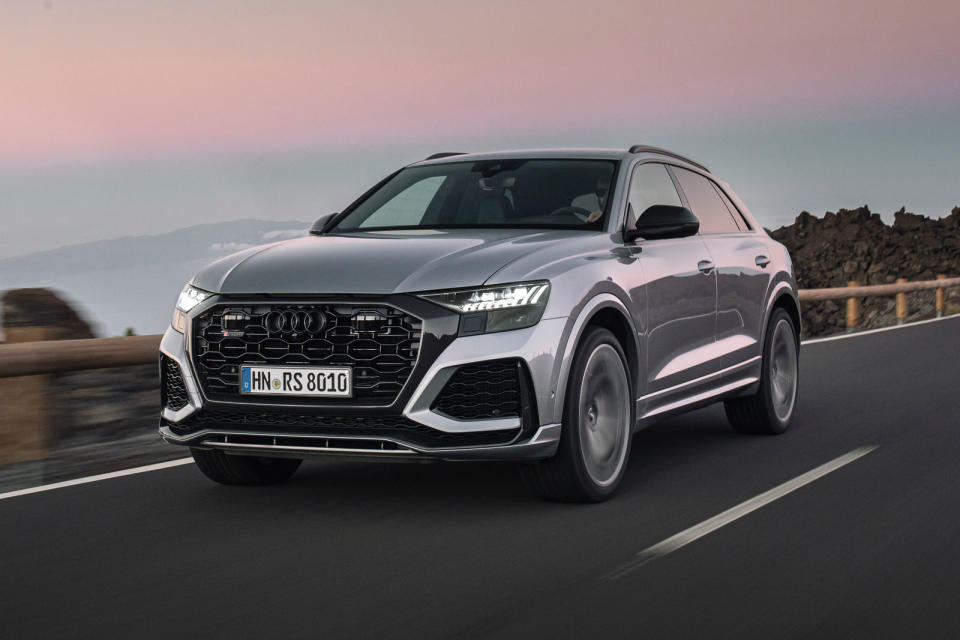Audi RS Q8

This is Audi’s latest high performance flagship, which perhaps inevitably these days is based on an large SUV, in this case the Audi Q8. In fact, by being a go-faster version of a premium badged coupé-inspired off-roader, the new RS Q8 is arguably a niche within a niche within a niche.
While that makes it sound like it operates in a class of one, the 592bhp machine actually arrives in a hotly contested sector that’s already populated by cars such as the closely related Porsche Cayenne Coupe Turbo, the BMW X6M Competition and Mercedes GLE Coupe 63 S, to name but a few.
We’ve already had a chance to ride shotgun in the RS Q8 for a quick lap of the fearsome Nürburgring Nordschleife (where it set a 7min 42.253sec lap time to become the fastest SUV around the circuit) with Audi factory ace Frack Stippler, and even from the passenger seat it was clear the Audi devoured straights with alarming alacrity and seemed to cope with corners equally effortlessly. Yet you can’t come to any real conclusions until you’ve climbed behind the wheel yourself, which is why we’re in Tenerife and about to tackle some of the epic roads that cover the island’s arresting lava-formed landscape.
But before we do, a quick recap, because there’s a fair bit going on with the RS Q8. Underneath its aggressively enhanced Q8 skin (the legendary Group B S1 quattro is said to have influenced the go-faster add-ons, although you’d be hard pressed to see the similarities) is an upgraded Audi SQ8. Out goes that car’s diesel engine, replaced by the same twin-turbocharged 4.0-litre V8 petrol that serves in the Porsche Cayenne Turbo and Lamborghini Urus. Here it delivers the aforementioned 592bhp and 590lb ft (That’s more than the Porsche, but less than the Lambo). There’s also a 12kW starter/generator that gives the unit mild-hybrid status, plus cylinder deactivation.
Drive is transmitted to all four wheels via an eight-speed automatic to four-wheel drive that can channel up to 80% of the torque to the back axle (40/60 front to rear is the default setting) and is equipped with an active torque vectoring limited slip differential.
Suspension modifications run to a wider track (10mm front and 5mm rear), revised damper rates for the adaptive air suspension and the option of a 48V anti-roll system that’ll be familiar to Porsche and Bentley owners. Our car was fitted with this kit alongside optional 23-inch alloys (21s are standard), although the 295mm width of the tyre is the same regardless of wheel diameter. There’s also four-wheel steering (standard on the flagship Vorsprung), which can turn the back wheels up to five degrees in the opposite direction to the fronts at low speed, and 1.5 degrees in the same direction above 37mph.
Arguably it’s the four-wheel steer that sets the tone for the RS Q8, its ability to quickly rotate the rear of the car to quell understeer helping deliver agility that simply shouldn’t be possible for a car of this size and weight.
Regardless of driver mode – there are a bewildering array of settings, some of which can be stored and saved for quick access via a steering wheel-mounted RS button – the steering is fairly mute. But the rack is quick and the weighting is reasuringly hefty, plus there’s plenty of turn-in bite, allowing to commit to the apex with real confidence. And with the rear steer getting you pointing staighter sooner, you can get on the throttle earlier and exploit the double whammy effect of that torque vectoring diff and four-wheel-drive traction. The anti-roll wizardry plays its part too, helping keep things on an even keel and under cast iron control. It’s not fun and engaging in the normal sense and you feel that the systems are doing a lot of the work, but it’s hard not to giggle a little at the vast RS Q8’s ability to deal with corners and changes of direction with near hot-hatch poise and agility. It doesn’t mess about on the bits in between, either.
Once the compressors are really boosting above 2000rpm the V8 fires the RS Q8 along with a deep-chested, relentless energy, while in Dynamic mode the twin exhaust’s subtle baritone is enhanced by some pops and bangs on the overrun. And while the optional carbon ceramic brakes suffer from a dead patch at the top the pedal travel when you’re pootling, work them hard and they deliver powerful, fade-free and easily modulated retardation. If there’s a criticism of the drivetrain, it’s that the eight-speed auto can slot home ratios a bit jerkily in its most aggressive mode.
Dial everything back and the RS is pretty much as easy to live with as a standard Q8, with the exception that even in its softest setting there’s an underlying firmness to the ride. The cabin is spacious and classy with the same wall-to-wall TFT screens, plus there’s room for five and a usefully large boot. Hell, it’ll even go off-road if you want, the air-suspension jacking the whole car up by 50mm for greater ground clearance. Towing horseboxes across muddy fields shouldn’t be a problem either.
Given its size and mass the RS Q8’s dynamic abilities are frankly outrageous, and while it’s not cheap it undercuts all of its less powerful rivals. Yes, you can easily argue cars like this represent conspicuous consumption of the worst kind and, in the RS Q8’s case, it’s hard to fight its corner in the fast family transport stakes in the face of the quicker, cheaper and more spacious RS6.
Yet as a physics-bashing engineering achievement, it’s hard not to admire the RS Q8. And of course, it doesn’t hurt that it undercuts the less powerful Porsche Cayenne Coupe Turbo yet includes many of that car’s optional dynamic driver aids as standard.
]]>

 Yahoo Autos
Yahoo Autos 
